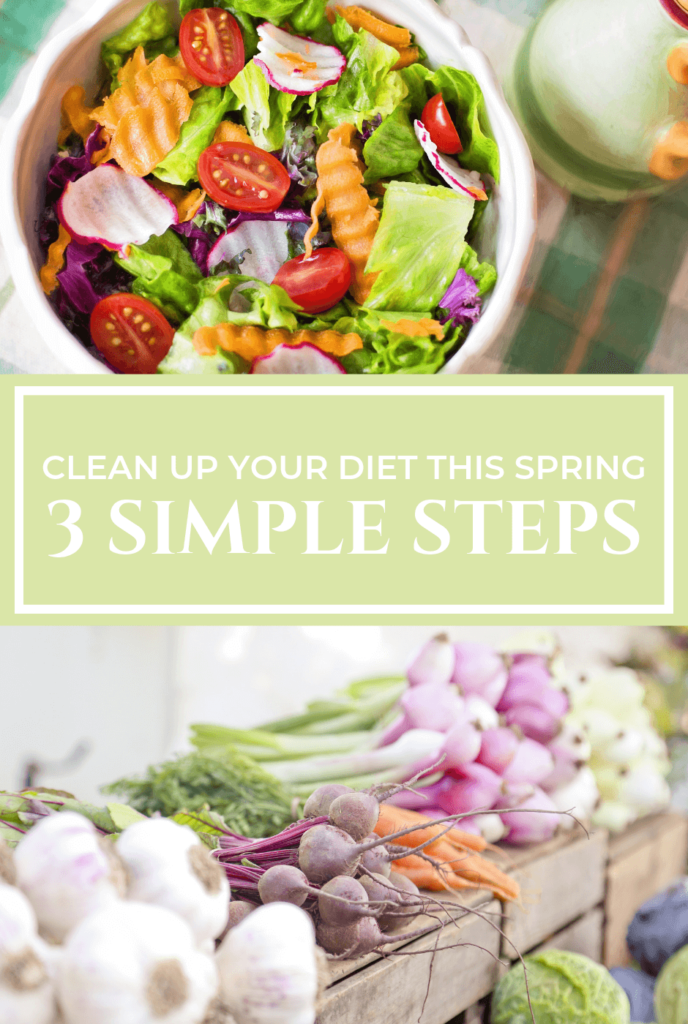Spring is a time when many of us switch up our eating habits from heavy winter stews to lighter foods. Why not take the opportunity to clean up your diet as well as your home this spring? In this article, I’ll walk you through 3 easy steps that will help you clean up your diet and I’ll guide you through making smart nutritional choices without compromising on all the flavours spring has to offer.

CLEAN UP YOUR DIET BY FOLLOWING THESE 3 EASY STEPS:
STEP 1: TAKE SOME TIME TO PLAN
Eating clean during the spring can seem challenging when the prospect of celebrating the snow melting by overdosing on heavy grilled meat marinated in sweet barbecue sauce pops in our head. Thankfully, just like it is possible to maintain healthy eating habits during the Holidays, springtime is no different.
The most effective way to clean up your diet is to plan your meals ahead of time and to stay organized. Start by getting inspired by browsing your favourite warm-weather recipes, as well as some you would like to try. Looking forward to the food you plan to make will make you more likely to stay on track. Trust me, healthy food can be just as exciting as the dishes you are accustomed to!
Next, you’ll want to make a list of the food staples required for the recipes you selected and check which ones are missing from your pantry. From there, make sure to purchase these items the next time you go grocery shopping so you’re good to go.
The planning phase is also the time where you should get your fruit and vegetable consumption organized. Make sure you know where you will source your fresh ingredients during the season, whether you’re planning to subscribe to a produce basket delivery service or simply visiting your local farmers’ market.
STEP 2: DECLUTTER & ORGANIZE YOUR FOOD STORAGE
This step is crucial when you want to clean up your diet because all your careful planning isn’t immune to temptation or unhealthy foods masquerading as healthy nutrition choices. When organizing your food storage areas, keep the nutrient dense foods in plain view, and keep the treats up high in the back. Out of sight really does mean out of mind. If you do not see it you will be less likely to be tempted.
Let’s have a look at some simple strategies you can use to spring clean your food storage areas effectively.
SPRING CLEAN YOUR PANTRY
Let’s face it: life can get busy and processed foods can drastically cut down on your cooking time. The good news is that not all processed foods are created equal and some of them can be a part of a healthy diet.
To identify what you should discard, start by having a look at the items in your pantry and replacing heavily processed foods with ones that are minimally processed. Let’s use tomatoes as an example. In an ideal world, you would want to cook with fresh tomatoes. However, minimally processed tomatoes (i.e. canned tomatoes that have nothing added to them) are a great backup option. On the other hand, commercial tomato sauce isn’t usually an ideal choice since it has more chance of containing indesirable ingredients like added fat, sugar and salt.
A good rule of thumb to follow when shopping for items to stock your pantry is to read the labels carefully. Make sure that the ingredient list is short and includes as few unpronounceable ingredients as possible.

SPRING CLEAN YOUR FRIDGE AND FREEZER
Start by looking at the labels of the processed foods you keep in your fridge, in the same way you did for your pantry. These would include items such as salad dressings, sauces, relishes and jams.
Once you’ve discarded your old mayonnaise, try replacing it with a nutritious alternative such as Greek yogurt. Opting for lighter salad dressings based on balsamic vinegar or lemon juice is a great way to add a fresh, zesty flavour to spring vegetables and make them even more enjoyable.
Next, check all the best before dates, and discard the ones that have been open for a long time. Remember, for some foods the best before date refers to the period of time when the food is “best” to consume prior to being opened. Once opened the best before dates no longer apply and the food may only be good for a period ranging from 4-5 days for items like broth to 2-3 months for condiments. Similarly, frozen foods do not last forever. Health Canada has a great table that indicates how long to safely store food in the refrigerator or freezer. Feel free to use it as a guide as you declutter your food storage areas.
STEP 3: MAKE YOUR KITCHEN SPRING-READY
Organizing your kitchen gadgets, containers and small appliances in a strategic way can really give you an extra edge when trying to clean up your diet.
Start by breaking down the task into smaller jobs. When I go through this process, the first place I start with is with my small appliances. I make sure to put the ones that I use more in the winter in storage to make room for the ones that get used in the summer. For instance, the slow cooker gets put away and the tools for preparing fruits and vegetables like the mandolin come upstairs.
Then I move on the drawers and cabinets, starting with my gadget drawer. Using the same strategy, I put away the potato masher and get out the strawberry huller.
Finally, I clean out the storage containers, making sure I have enough to store the fresh produce, that they all have matching lids and that they are in good condition.

QUICK TIPS FOR A CLEAN DIET PACKED WITH FLAVOUR
Sauces and Dressings
BBQ sauce, ketchup and a host of other condiments can be a source of hidden sugar. If you do have some extra time, making your own from scratch is ideal because you can add your own sugar and that gives you control. Very often you can reduce the amount of sugar in a recipe by a third and see no appreciable difference in taste!
Refreshing drinks
In the spring and summertime, we do not crave desserts as much as in the colder months, but we seem to have more opportunity to consume alcoholic beverages as well as refreshing sweet drinks such as iced tea and juices. These are often calorie-laden punches.
Of course, these beverages are fine to enjoy in moderation, but make sure not to rely on them to keep you cool. As a lower sugar alternative, try infusing your water with some of your favourite fruit overnight in the fridge for a fun and customizable way to stay hydrated.
Frozen Treats
Just like alcoholic beverages, frozen desserts like ice cream and frozen yogurt are high in calories and fine to enjoy occasionally as a treat. You can easily make a healthier version by blending some greek yogurt and a handful of fruit together and freezing the mix in popsicle moulds.
Meat & Other Protein Sources
This is the perfect time of the year to include fish and seafood on the menu as a delicious alternative to traditional grilled meat. Some of the best fish to add to your diet include salmon, mackerel, anchovies, sardines, herring and trout.
Springtime is also a great time to include beans, peas and lentils in salads and burgers. The new Canadian Food Guide recommends to include more plant-based protein sources to our diet, so make sure to have fun and experiment!
Seasonal vegetables – with a twist!
Make sure to find fun ways to serve seasonal foods to add some variety to your meals. A simple way of doing that is to purchase a spiralizer and turn zucchini, carrots, cucumbers and beets into “noodles” that can be warmed and served with pasta sauce or served cold in a salad.

